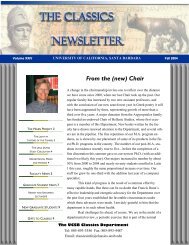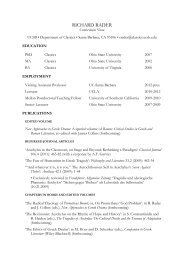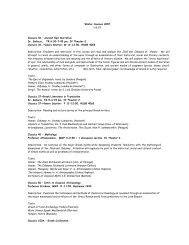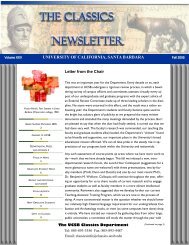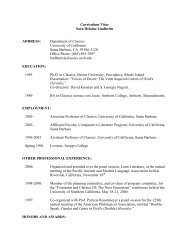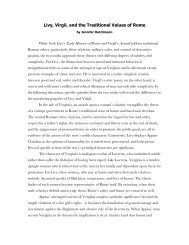Full C.V. - Department of Classics - University of California, Santa ...
Full C.V. - Department of Classics - University of California, Santa ...
Full C.V. - Department of Classics - University of California, Santa ...
You also want an ePaper? Increase the reach of your titles
YUMPU automatically turns print PDFs into web optimized ePapers that Google loves.
CURRICULUM VITAE<br />
JO-ANN RUTH SHELTON<br />
Education<br />
UC Berkeley, PhD, <strong>Classics</strong>, 1974<br />
UC Berkeley, M.A., <strong>Classics</strong>, 1968<br />
<strong>University</strong> <strong>of</strong> Manitoba, B.A. (Hons), <strong>Classics</strong> and English, 1966<br />
Academic Appointments<br />
2008 - Research Pr<strong>of</strong>essor, <strong>University</strong> <strong>of</strong> <strong>California</strong>, <strong>Santa</strong> Barbara<br />
1986-2008 Pr<strong>of</strong>essor, <strong>Classics</strong>, UCSB<br />
1979-1986 Associate Pr<strong>of</strong>essor, <strong>Classics</strong>, UCSB<br />
1975-1979 Assistant Pr<strong>of</strong>essor, <strong>Classics</strong>, UCSB<br />
1972-1975 Lecturer, <strong>Classics</strong>, UCSB<br />
Administrative Appointments<br />
1997-2001 Chair, Environmental Studies <strong>Department</strong>, UC <strong>Santa</strong> Barbara<br />
1989-1992 Associate Dean, College <strong>of</strong> Letters and Sciences, UCSB<br />
Publications<br />
Books<br />
The Women <strong>of</strong> Pliny's Letters (Routledge 2012).<br />
As the Romans Did, 2 nd edition (revised and expanded). Oxford <strong>University</strong> Press, 1998.<br />
Hercules Furens. The Madness <strong>of</strong> Hercules. Coronado Press, 1991.<br />
As the Romans Did. Oxford <strong>University</strong> Press, 1988.<br />
Seneca's Hercules Furens: Theme, Structure and Style. Vandenhoeck & Ruprecht, 1978.<br />
Articles and Reviews<br />
"Spectacles <strong>of</strong> Animal Abuse," in The Oxford Handbook <strong>of</strong> Animals in Classical Thought and<br />
Life (Oxford <strong>University</strong> Press, 2014), pp. 461-477.<br />
"Decline <strong>of</strong> Paganism, Rise <strong>of</strong> Christianity: Why Christianity Became the Dominant Religion."<br />
World Religions: Belief, Culture, and Controversy. ABC-CLIO, 2014. Web. 20 Jan. 2014.<br />
Review <strong>of</strong> Fabio Tutrone, Filos<strong>of</strong>i e animali in Roma antica: Modelli di animalità e umanità in<br />
Lucrezio e Seneca. American Journal <strong>of</strong> Philology 134 (2013), pp. 709-713.<br />
"Tuer les animaux qui ne cadrent pas: les dimensions morales de la restauration d'habitats,"
translation <strong>of</strong> 2004 article, in Sentients des villes, sentients des champs, http://sentientslibres.blogspot.fr/2013/06/<br />
Review <strong>of</strong> Margo DeMello, ed., Teaching the Animal: Human-Animal Studies across the<br />
Disciplines. Anthrozoos 24 (2011), pp. 104-106.<br />
"The State and the Family," in A Cultural History <strong>of</strong> Childhood and the Family in<br />
Antiquity (Berg 2010), pp. 115-131.<br />
Review <strong>of</strong> Thomas McGinn, Widows and Patriarchy: Ancient and Modern. Classical<br />
Bulletin 85 (2010), pp. 47-49.<br />
"Exotic Species," in The Encyclopedia <strong>of</strong> Animal Welfare (Greenwood 2010), pp. 230-<br />
236.<br />
“Beastly Spectacles in the Ancient Mediterranean World,” in A Cultural History <strong>of</strong><br />
Animals in Antiquity (Berg 2007), pp. 97-126.<br />
“Exotic Species,” in The Encyclopedia <strong>of</strong> Human-Animal Relationships (Greenwood<br />
2007), pp. 345-352.<br />
“Animals in Ancient Roman Arenas,” in The Encyclopedia <strong>of</strong> Human-Animal<br />
Relationships (Greenwood 2007), pp. 887-891.<br />
Review <strong>of</strong> John Heath, The Talking Greeks: Speech, Animals and the Other. American<br />
Journal <strong>of</strong> Philology 127 (2006), pp. 603-607.<br />
Review <strong>of</strong> A. Schiesaro, The Passions in Play: Thyestes and the Dynamics <strong>of</strong> Senecan<br />
Drama. Vergilus 52 (2006), pp. 216-221.<br />
“Elephants as Enemies in Ancient Rome.” Concentric 32 (2006), pp. 3-25.<br />
Review <strong>of</strong> S. Armstrong and R. Botzler, The Animal Ethics Reader. Anthrozoos 18<br />
(2005), pp. 434-440.<br />
“Putting Women in Their Place: Gender, Species, and Hierarchy in Apuleius’<br />
Metamorphoses,” in Defining Gender and Genre in Latin Literature (Peter Lang 2005), pp.<br />
301-329.<br />
Review <strong>of</strong> B. Severy, Augustus and the Family at the Birth <strong>of</strong> the Roman Empire.<br />
Classical Outlook 82 (2005), pp. 157.<br />
“Dancing and Dying: The Display <strong>of</strong> Elephants in Ancient Roman Arenas,” in<br />
Daimonopylai (<strong>University</strong> <strong>of</strong> Manitoba Press 2004), pp. 363-382.<br />
“Killing Animals that Don’t Fit In: Moral Dimensions <strong>of</strong> Habit Restoration.” Between the
Species (2004).<br />
Review <strong>of</strong> S. E. Phang, The Marriage <strong>of</strong> Roman Soldiers. Classical Outlook 80 (2002), pp.<br />
40-42.<br />
“Seneca the Younger,” in Encyclopedia <strong>of</strong> the Ancient World (Salem Press 2001), pp.<br />
999.<br />
“Seneca the Elder,” in Encyclopedia <strong>of</strong> the Ancient World (Salem Press 2001), pp. 999-<br />
1000.<br />
Review <strong>of</strong> W. Fitzgerald, Slavery and the Roman Literary Imagination. American<br />
Journal <strong>of</strong> Philology 122 (2001), pp. 599-604.<br />
“The Display <strong>of</strong> Elephants in Ancient Roman Arenas.” ISAZ Newsletter 21 (2001), pp. 2-6.<br />
“The Spectacle <strong>of</strong> Death in Seneca’s Troades” in Seneca in Production (Classical Press <strong>of</strong><br />
Wales 2000), pp. 86-118.<br />
“Elephants, Pompey and The Reports <strong>of</strong> Popular Displeasure in 55 B.C.,” in Veritatis<br />
Amicitiaeque Causa (Bolchazy-Carducci 1999), pp. 231-271.<br />
Review <strong>of</strong> M. J. Dobson, Food in Antiquity. Religious Studies Review 25 (1999), pp. 78-<br />
79.<br />
“The Contributions <strong>of</strong> Ancient Greek Philosophy to the Modern Debate about Animal<br />
Use,” in Ancient Greece and the Modern World (<strong>University</strong> <strong>of</strong> Patras Press, 1998), pp.<br />
85-93.<br />
“Shooting Sheep to Save Sagebrush: The Violence <strong>of</strong> Habitat Restoration.” Electronic<br />
Green Journal, <strong>University</strong> <strong>of</strong> Idaho. Special Issue 9 (1998).<br />
Review <strong>of</strong> J. Donald Hughes, Pan’s Travails: Environmental Problems <strong>of</strong> the Ancient<br />
Greeks and Romans. Echos du Monde Classique 42 (1998), pp. 221-228.<br />
“Feral Horses in a National Park: A Conflict <strong>of</strong> Values in Preserving Species,” in Our<br />
Natural Environment: IEA Proceedings (1997), pp. 278-285.<br />
“Family Matters: The Structure and Dynamics <strong>of</strong> the Ancient Roman Family.”<br />
Laetaberis 11 (1996), pp. 1-27.<br />
“Lucretius on the Use and Abuse <strong>of</strong> Animals.” Eranos 93 (1995), pp. 48-64.<br />
“Contracts with Animals: Lucretius, De Rerum Natura.” Between the Species 11 (1995), pp.<br />
115-121.
“Paradigm and Persuasion in Seneca’s Ad Marciam.” Classica et Mediaevalia 46 (1995), pp.<br />
157-188.<br />
Review <strong>of</strong> J. Masters, Reflections <strong>of</strong> Nero. Classical Philology 90 (1995), pp. 296-301.<br />
Review <strong>of</strong> B. Rawson, Marriage, Divorce and Children in Ancient Rome. Echos du<br />
Monde Classique 37 (1993), pp. 517-521.<br />
"Roman Spectacles," in From Augustus to Nero: The First Dynasty <strong>of</strong> Imperial Rome<br />
(Michigan State <strong>University</strong> Press, 1990), pp. 221-236.<br />
"Bread and Circuses: The Politics <strong>of</strong> Entertainment," in From Augustus to Nero: The<br />
First Dynasty <strong>of</strong> Imperial Rome (Michigan State <strong>University</strong> Press, 1990), pp. 237-263.<br />
"Pliny the Younger and the Ideal Wife." Classica et Mediaevalia 41(1990), pp. 163-186.<br />
"Pliny's Letter 3.11: Rhetoric and Autobiography." Classica et Mediaevalia 38 (1987), pp.<br />
1-19.<br />
"Human Knowledge and Self-Deception: Creon as the Central Character <strong>of</strong> Sophocles'<br />
Antigone." Ramus 13 (1985), pp. 102-123.<br />
"Revenge or Resignation: Seneca's Agamemnon." Ramus 12 (1983), pp. 159-183.<br />
"Structural Unity and the Meaning <strong>of</strong> Euripides' Herakles." Eranos 77 (1979), pp.101-<br />
110.<br />
"Seneca's Medea as Mannerist Literature." Poetica 11 (1979), pp. 38-82.<br />
“The Dramatization <strong>of</strong> Inner Experience: The Opening Scene <strong>of</strong> Seneca’s Agamemnon.”<br />
Ramus 6 (1977), pp. 33-82.<br />
"Chariot Racing: Ancient Rome's Most Popular Spectator Sport." Chariot Racing World<br />
5 (1976), pp. 9-17.<br />
"Problems <strong>of</strong> Time in Seneca's Hercules Furens and Thyestes." <strong>California</strong> Studies in<br />
Classical Antiquity 8 (1975), pp. 257- 269.



